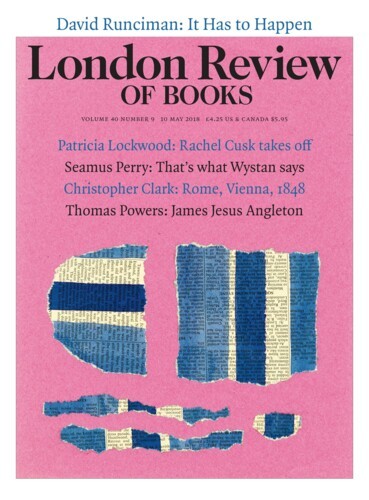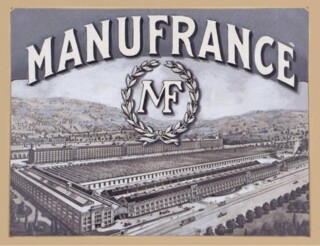Where would I find a hardware store in Marseille? I was on holiday fifty miles north of the city. ‘The Maison Empereur,’ my friend replied. ‘It’s an amazing place.’ The next morning, I drove to the coast: the hardware shop is near the old port. Marseille was founded 2600 years ago by Phocaeans, Greeks from Anatolia, known for their coinage and for the galleys they made to move themselves, their merchandise and their money, from one end of the Mediterranean to the other. The city’s port has forever been central to the trade of the sea: in Fernand Braudel’s The Mediterranean and the Mediterranean World in the Age of Philip II, Marseille is mentioned so often that when you turn to its entry in the book’s index, you find no page numbers, just a word – passim.
Lauso la mare e tente’n terro – praise the sea and stay on the land – is a Provençal proverb, and Marseille remains a city where the two meet. Enormous cruise and container ships arrive at its quays – you see them as you drive the elevated motorway into the city. The ferries that go to and from Corsica, Sardinia, Tunisia, Algeria, and Morocco are there, too. Ports like this one no longer exist in Britain.
Marseille is well visited, but quarters of the city have reputations for such violence they remain out of sight. That has almost always been so. Pétain refused to make Marseille the capital of unoccupied France because its lawlessness was at odds with the virtuous nation he claimed to represent. Defying rules and laws forms part of the city’s mythology: its most famous dish – bouillabaisse – is emblematic of that defiance of codification. Despite all the attempts to standardise it, no one bouillabaisse is the same as another. The fish you use matters less than the broth. The dish, with its rapid boiling and slower simmering, as the name implies, was, in any case, the work of those ancient Greeks – or Venus, who used it to put her husband to sleep. Rascasse, a scorpion fish also known as a sea robin, is a typical ingredient of bouillabaisse: the venom in the spines of its dorsal fin becomes inert when cooked.
I had several questions for that friend the night before I drove to Marseille. How, for example, to get to the Château d’If, where enemies of the French state were once interred. I’d flown into Marseille a few days earlier, and stared down at the island prison as the plane banked around it and came into land. The island’s most famous prisoner was Edmond Dantès, Count of Monte Cristo, only he’s a character in a novel.
Where should I buy fish? At one of the shops on the rue Longue-des-Capucins, was the answer, just to the south of the city’s famous boulevard, la Canebière, a word that originates from the Latin for hemp – rope-makers were some of the street’s earliest occupants. Conrad, who worked cargo ships out of Marseille, said that to walk the Canebière was a walk into the unknown. Can O’Beer – of course – was how British sailors made the unknown all too familiar. Then I asked about the hardware shops. I had been to Marseille a few times to see its new and old museums, but the Maison Empereur had never been mentioned before. ‘I’ll come with you,’ said my friend.
The sea was too rough for the boat journey to Château d’If: the market, with its two fishmongers, was round the corner from the Maison Empereur, in a quarter named after aristocratic diplomats, the Noailles. More commonly known as the belly of Marseille, this was where the land once hoovered up what had arrived by sea, not just from other Mediterranean ports, but from the barge traffic of the Rhône, and where all the merchandise was put into shops and warehouses, or sold on stalls on the quays or nearby streets. Noailles isn’t the market it was, and the shops on rue Longue-des-Capucins have a less specifically French and more general Mediterranean feel about them: east, west, European, North African – Marseillais.
Maison Empereur is a hardware shop unlike any hardware shop I have been to: it may be very much more recent than the arrival of the Greeks – but there aren’t many shops in Europe that are 191 years old. Beretta, the Lombardy gunmaker, was founded in the 16th century – it made cannons for the Venetian fleet at the Battle of Lepanto in 1571. The St James’s wine merchants, Berry Brothers & Rudd, established themselves in 1698. Lhardy is a restaurant and delicatessen off the Puerto del Sol in Madrid that’s been going since the 1830s. Guns, booze and food seem more likely to be lasting; hardware more likely to fall away. Not so with the Maison Empereur: it was founded in 1827 and expanded in 1845 by Louis Empereur, a wood carver and toolmaker. His shop has remained and grown on the same street – on a stretch of the rue des Récolettes – and is now run by Laurence Renaux-Guez, a sixth-generation Empereur, and its first woman director. Her father was part of the French Olympic shooting team in the 1960s, and opened an armoury department over the road. It doesn’t only sell guns; tear gas, mace, knuckledusters and hunting knives are all in the shop’s windows; every passer by gapes at all this hardware. Gun ownership in France has halved in the last 15 years but you wouldn’t think so looking through the armoury windows with their pistols and other weapons that you don’t associate with either hunting or Olympic sports.
Before Renaux-Guez took the helm, the store was made up of four shops each with its own entrance, connected with one another through internal passages. She has made it look more like one shop, even if each department has its own specialists. Despite her efforts, the shop remains a warren – or an empire. Some of its suppliers have been working with the Maison Empereur for decades, and shop that it may be, it is also a museum devoted to those thousands of quotidian items of hardware made during the 19th-century industrial revolution. The word MANUFRANCE dominates an early 20th-century poster reproduced inside the Maison Empereur’s newspaper-like history of itself, which is handed out to customers.
It doesn’t stock electrical appliances, but the shop is not a tomb. Everything on sale has purpose to it: plumbing, carpentry, wiring, lighting, cooking, washing or shooting. You feel a little incompetent when you see what you might do. Over two floors the shop seems to have everything: saucepans, brooms, towels, frying pans, soaps, pots, knives, saws, wood shavers, light brackets, brushes, hot-water bottles, shoe horns, steel toe-caps, eau de cologne, dusters, wooden spoons, and many objects whose purpose I wouldn’t be able to guess. The shop has 150,000 different items for sale; the inventory isn’t computerised and there’s no heating and no air-conditioning. No one room is the same as any other, each is packed with customers, the staff wear blue jackets – bleus de travail – receipts are handwritten, whatever you buy will be wrapped in brown paper.
These are the words at the top of a poster that also depicts one of the Empereur family who ran the shop: General Supplies, Commercial Industrial Agricultural & Building Hardware, Ironwork, Locks, Tools, Steelwork, Copper, Iron & Cast Iron. The family have gone out of their way to live up to their name. When you enter the shop today you find yourself in its knife section; kitchen knives, table knives, pocket knives and penknives – knives that you can’t have on you in Britain any longer. That room leads into two rooms given over to kitchenware: the Empereur has always sold cooking equipment – the arrival of cheap iron cooking dishes in rural France, a phenomenon of the 1830s and 1840s, coincided with the foundation of the shop. The history of cooking seen from the point of view of its technology is still an unwritten book: the records of the Maison Empereur would be one good source. Was bouillabaisse quite the same dish before the advent of cheap ironware, for instance?
M.F.K. Fisher doesn’t mention the Maison Empereur in her book about Marseille, A Considerable Town, published in 1983, but an independently owned hardware store can’t then have seemed as unusual as it does now, when such shops have so often closed down or been replaced by chain stores. In the 1950s and 1960s, the Empereur would have appeared ordinary; now it looks new. A clothes shop is a more recent expansion. I spied a jacket I didn’t need; within a minute I’d bought it. I rang the house where I was staying and asked whether there was anything I should get. I explained the scope and the size of the shop. A new brain was the answer I got, one piece of hardware not for sale at the Maison Empereur. I left Marseille with the jacket as well as a frying pan, and the ingredients for the bouillabaisse I would make that night.
Send Letters To:
The Editor
London Review of Books,
28 Little Russell Street
London, WC1A 2HN
letters@lrb.co.uk
Please include name, address, and a telephone number.


